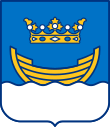
Katajanokka is a neighbourhood of Helsinki, Finland, with around 4000 inhabitants in 2005. The district is located adjacent to the immediate downtown area, though in the first major town plan for Helsinki from the mid-18th century, the area fell outside the fortifications planned to encircle the city.

Lars Eliel Sonck was a Finnish architect. He graduated from Helsinki Polytechnic Institute in 1894 and immediately won a major design competition for a church in Turku, St Michael's Church, ahead of many established architects. The church was designed in the prevailing neo-Gothic style. However, Sonck's style would soon go through a dramatic change, in the direction of Art Nouveau and National Romanticism that was moving through Europe at the end of the 19th century. During the 1920s, Sonck would also design a number of buildings in the emerging Nordic Classicism style.

Kulosaari metro station is a ground-level station on the Helsinki Metro. It serves the island district of Kulosaari in East Helsinki. There are 50 bicycle and 36 car parking spaces at the station. Both lines M1 and M2 serve Kulosaari.
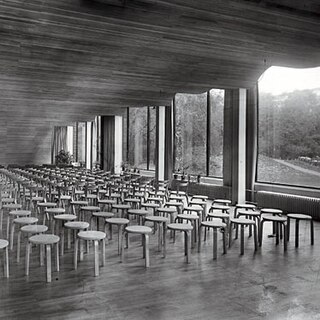
The architecture of Finland has a history spanning over 800 years, and while up until the modern era the architecture was strongly influenced by currents from Finland's two respective neighbouring ruling nations Sweden and Russia, from the early 19th century onwards influences came directly from further afield: first when itinerant foreign architects took up positions in the country and then when the Finnish architect profession became established.

Armas Eliel Lindgren was Finnish architect, professor and painter.
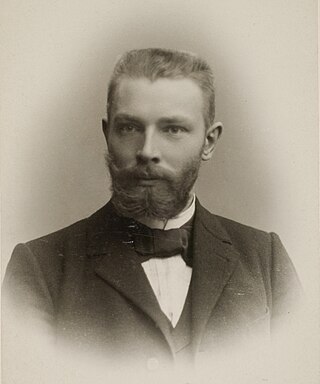
Valter Thomé was a Finnish architect who worked in the National Romantic or Art nouveau style.

Pauli Ernesti Blomstedt, more commonly known as P. E. Blomstedt, was a Finnish architect and designer, who worked first in the Nordic Classicism style and then turned to Functionalism. Both his father, Yrjö Blomstedt, and younger brother, Aulis Blomstedt, were also well-known architects.

Zachris Usko Nyström, known as Usko Nyström, was a Finnish architect and one of the most influential professors of architecture at Helsinki University of Technology; among his students were later notable architects Eliel Saarinen and Alvar Aalto. One of the pioneering architects of the early Art Nouveau or Jugendstil style in Finland at the end of the 19th and beginning of the 20th century, he continued to influence generations of students by introducing them to the style. Many of his key architectural works were made while he was in the architectural partnership Usko Nyström─Petrelius─Penttilä which operated from 1895 to 1908. His most famous work is the Grand Hôtel Cascade (1903) in Imatra.

Fabianinkatu 17 is a national romantic-art nouveau building in central Helsinki. Built in 1900–1901 to a design by the architectural firm of Gesellius, Lindgren and Saarinen, it was originally a block of flats, but became increasingly used for offices and was for many years known as the Doctors' House. In 1953 Agronomiliitto, the Finnish Association of Agronomists, bought it, and it is now called Agronomitalo.

The Pohjola Insurance building is the former headquarters of the Pohjola Insurance Company at Aleksanterinkatu 44 and Mikonkatu 3 in central Helsinki. Primarily designed by Gesellius, Lindgren & Saarinen and constructed in 1899–1901, it is a prominent example of Finnish national romantic architecture. It was acquired in 1972 by Kansallis-Osake-Pankki, now succeeded by Nordea.

The Kulosaari cemetery is the smallest cemetery in Helsinki parish union. It is situated on Iso-pässi island in Kulosaari district of Helsinki. It was inaugurated in 1925. The cemetery chapel was designed by architect Armas Lindgren and added in 1927. There is also an area for war heroes' graves.

Kulosaari Secondary School is a private secondary school located in Kulosaari, Helsinki, founded in 1940. It is an international school, teaching in both Finnish and English. The school comprises both lower secondary (yläaste) and upper secondary or gymnasium (lukio) stages, with approximately 900 pupils in total. Kulosaari is one of the leading gymnasia in the country by exam results.

Kulosaari Manor is a manor house and mansion located near the Kulosaari neighbourhood of Helsinki.
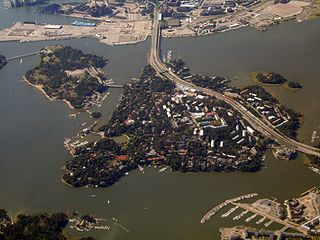
Mustikkamaa is an island in the Gulf of Finland, some 5 kilometres (3.1 mi) to the east of the city centre of Helsinki, and c. 36 hectares in size.
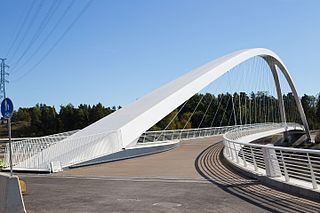
Isoisänsilta is a pedestrian and cycling bridge in Helsinki, Finland, opened in June 2016.

Embassy of Iraq in Helsinki is located in the district of Kulosaari and sticks out due to its Middle-Eastern architecture. At first this was met with scepticism and resentment from the locals since the building was so different from the rest of the building in Kulosaari. However, due to the diplomatic immunity, the state of Iraq was free to design its own embassy however it wanted.

Sompasaari is an island on the Kruunuvuorenselkä water area in the Sörnäinen district in Helsinki, Finland. On the southern side of the Nihdinkanava channel built in the middle of Sompasaari is the former island of Nihti.

(Axel) Bertel Jung was a Finnish architect and urban planner, notable as Finland's first official zoning architect and a pioneer in the field of city planning.
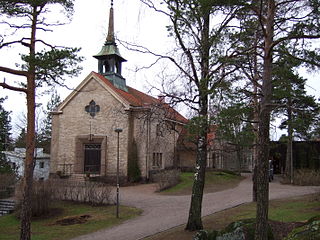
Kulosaari Church is a Lutheran church located in the Kulosaari suburb of Helsinki, Finland.
Allan Richard Achates Granfelt was a Finnish businessman who was involved in founding the Kulosaari Villa City, and served as the first manager of the Kulosaari Company. His nickname in Swedish was Brändö Kejsare, Kulosaaren Keisari in Finnish.






























